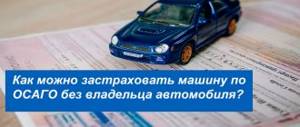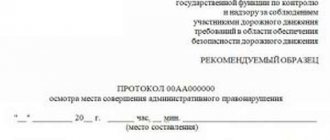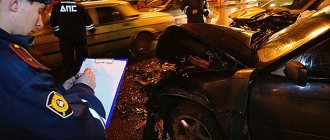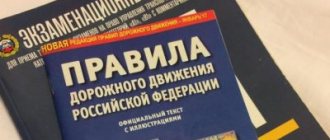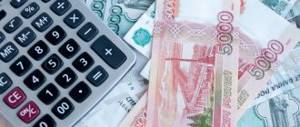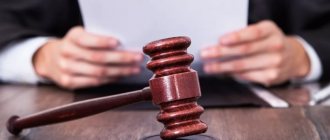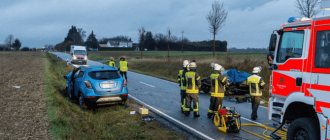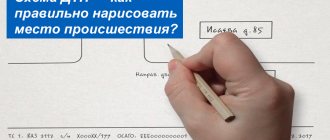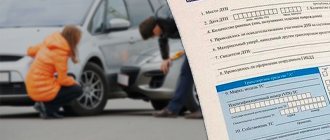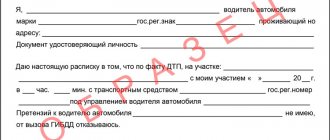Features of accident investigation
Features of the investigation of an accident case depend on its circumstances:
- whether its participants are alive and able to testify;
- were there any eyewitnesses to the event;
- Is the inspection of the accident site, cars informative, or is it necessary to conduct examinations?
Sometimes, after visiting the address and drawing up a report, the picture of the incident is clear. In other cases (death or escape of one of the participants, conflicting testimony of the survivor, witnesses, absence of the latter), additional measures are needed to clarify the situation:
- performing automotive technical examination;
- identifying and searching for the runaway driver, detaining him without delay;
- identification of vehicles involved in the accident;
- conducting a re-inspection of the accident site;
- forensic medical, forensic examination;
- more detailed examination of physical evidence;
- searching for eyewitnesses if they do not come forward themselves;
- repeated interviews with eyewitnesses;
- investigative experiment;
- analysis of data obtained from those who saw the event, participants, as a result of examinations.
We recommend reading about the registration of an accident by an accident commissioner. From the article you will learn about who emergency commissioners are, their responsibilities, and the advantages of registering an accident by a specialist. And here is more information about in what cases your license is deprived for an accident.
Accident without injuries
If there were no injuries in the accident, then the duties of the drivers involved in the accident are to record what happened. The best way is to film or take photographs. It is important that it is clearly visible:
- location of cars, as well as other significant objects. And not only relative to each other, but also to the entire road infrastructure. Ideally, take a general plan of the incident;
- the vehicles themselves with state license plates;
- close-up of the damage received.
After this, the cars can be moved so that they do not interfere with other road users. Please note that it is not only permitted to move your cars after all the circumstances of the accident have been recorded, but it is the responsibility of the drivers involved in the traffic accident if the cars are parked on the road. Otherwise, you may be fined for failure to perform duties in an accident.
Traffic police analysis group
The analysis group is formed in the traffic police from employees specializing in investigating the circumstances of car accidents. They must review the case materials offered to them, obtain new data in order to establish:
- how the event happened;
- who is guilty of it;
- what rules and laws were violated by the driver.
The administrative practice group can do a lot to clarify the circumstances of the accident. But sometimes the police simply persuade the driver to admit guilt, although this is not the case. The motorist has a chance to avoid a mistake. After all, the group’s decision is not final and can be appealed.
Investigator after an accident
An investigator from the traffic police enters into the investigation after an accident if the inspector who went to the scene did not identify the culprit. This employee establishes additional circumstances, calls participants and witnesses, talks with them, accepts evidence presented by drivers, and orders examinations if necessary. Actually, the interrogator is one of the members of the analysis team. He can close the case by identifying the culprit, or send it to court.
Accident Investigator
An accident investigator works when people are seriously injured or killed in an accident. Then they open not an administrative, but a criminal case. The investigator's responsibilities also include:
- visiting the site for the purpose of inspection and seizure of material evidence;
- registration of the results of the procedure;
- establishing several versions of an event;
- their verification, that is, interrogation of participants, witnesses, appointment of examinations, investigative experiments, confrontations;
- drawing up an indictment;
- sending the case to court.
Consideration of an accident
Consideration of a traffic accident case includes:
- the inspector’s visit to the scene of the accident, recording and documenting the circumstances of its occurrence (inspection protocols, certificates, identifying and interviewing witnesses, diagrams, photos), taking explanations from the participants;
- analysis by investigators of information from papers compiled by a traffic police officer, an incident diagram, explanations from drivers, medical examination reports;
- the appearance of motorists involved in an accident to give evidence to the traffic police investigation team, if it is impossible to determine the culprit on the spot and make a decision on the violation and payment of a fine;
- appointment and execution of examinations that will provide answers to questions that arise during the review (this stage is not always present);
- registration of the results of the analysis in the form of a resolution.
Participating drivers have the right to supplement their explanations, ask about anything unclear, insist on involving specialists in the case, and record what is happening. If someone does not agree with the issued decision, it can be appealed within 10 days after receiving a copy. For this they turn to the court or to the higher management of the inspection.
Notify the insurer
The victim must notify his or her insurance company of the incident as soon as possible. It is advisable to do this immediately after the accident. Then, within five days, you must provide the insurer with a notice of the traffic accident. This can be done in person, by mail, or any other method that provides confirmation of delivery of the notice.
At the same time, the victim of an accident submits an application for insurance compensation. All other documents that you need to receive insurance payment can be provided later.
The person at fault must also send his or her part of the notice to the insurance company. However, if he does not do this, and the traffic accident is recorded by the traffic police, then this will not threaten him in any way. But if the inspectors did not register the accident, and the culprit does not send a notice to his insurer within five days, then he will have to independently pay for all the damage caused to the victim, this is the so-called recourse claim. Recourse is also possible if you decide to repair or dispose of your car within 15 days after issuing the European protocol.
How traffic accidents are analyzed in the traffic police
Analysis of road accidents in the traffic police with the participation of a group formed for this purpose occurs in several stages:
- employees first study the accident documents without the participation of the guilty and injured parties;
- drivers are notified of the date and place of the further procedure;
- at the appointed time they are invited to the office, where they are given the opportunity to once again describe their own vision of the situation;
- motorists provide evidence of their innocence (photos, videos, witness statements), and may demand the appointment of an examination;
- the review team must respond to the petition immediately and in writing;
- if an examination is ordered, they wait for its conclusion, after which the culprit is identified;
- a resolution is drawn up.
Drivers can be invited to the debriefing group one by one or together. The second option is more like a confrontation, but there is no violation of the law. Sometimes the truth is established easier and more accurately this way.
When can you not contact the traffic police?
But if there is no disagreement, you don’t have to report it to the police at all. Instead, drivers must choose one of three options:
- Drive independently to the nearest traffic police department to complete all the necessary documents. In this case, it is necessary to have photos or videos confirming the incident.
- Fill out the European protocol. This is allowed if there are no more than two participants in the accident. It is also worth remembering that when drawing up a European protocol, the maximum compensation cannot exceed the amount of 50,000 rubles. Exceptions are made only for Moscow, St. Petersburg, Moscow and Leningrad regions. In these territories, if an accident is recorded using the GLONASS system, and there are photos and videos confirming the accident, the payment ceiling is set at 400,000 rubles.
- There is no need to prepare any official documents at all. You will only need a receipt with a promise to compensate for the damage from the culprit or a receipt stating that the parties have no claims against each other.
The procedure for investigating road accidents for administrative and criminal violations
The procedure for investigating a traffic accident case for an administrative violation consists of:
- inspection by a traffic police inspector of the place and cars;
- drawing up protocols;
- issuing a violation order if one of the motorists admitted guilt;
- transferring documents to the analysis group or an investigator when both drivers consider themselves victims;
- examination by this authority of the circumstances of the accident;
- making a decision;
- execution by the culprit or appeal by him against the decision.
If there are dead or seriously injured, a traffic police officer calls an investigation team to the scene, as they are already considering a criminal case. Inspection and recording of the circumstances of the accident are carried out by a criminologist and investigator. The latter opens a criminal case, within the framework of which he interrogates participants, witnesses, and orders examinations. Investigators are working on his instructions. When the person responsible for the accident is identified, the case is sent to court.
Time frame for accident investigation
After an accident, only material damage can remain. In this case, the case is considered within the framework of an administrative investigation. How long before the responsible person must complete the process is established by Section 5 of Article 28.7 of the Administrative Code:
The period for conducting an administrative investigation cannot exceed one month from the moment the case of an administrative offense was initiated.
But if during this period it was not possible to discover all the circumstances of the incident, the investigation may be extended. This is regulated by the same article of the law:
- there are no casualties, but the case remains unclear, which means that its study may take another 1 month;
- the accident caused minor or moderate harm to health, it is possible that the process will be allowed to be extended to six months.
The decision is made by the superior officer of the traffic police officer who is handling the case of an administrative violation. The latter submits a written request for this purpose.
If there are serious injuries or deaths, the accident is considered as part of a criminal case. Here the time frame for the investigation is different:
- 2 months from the date of opening the case;
- it can be extended up to 3 months by senior management;
- in particularly difficult cases, the investigation is allowed to continue for up to a year.
All this is regulated by Article 162 of the Criminal Code of the Russian Federation.
We are on Twitter:
Login Registration
Automotive news
Rules for the movement of heavy trucks in the automatic weight control zone have been adopted. The Federal Tax Service has approved the application form for the death or destruction of a vehicle. In Russia, it is forbidden to disembark children without a ticket from buses. A new sign 6.22 has been introduced in the traffic rules - “photo and video recording” Testing for alcohol dependence has been postponed for another year. The Ministry of Health has updated the requirements for completing car first-aid kits, the Ministry of Transport has approved the procedure and terms for storing diagnostic maintenance cards. Obtaining permission for international transport will now be done in a new way. You can now check your MTPL policy for authenticity online. The Central Bank has set new tariffs for MTPL.
/ Legal articles on the topic of automobile law / Criminal liability under Art. 264 of the Criminal Code of the Russian Federation / Time frame for investigating a criminal case of an accident
Time frame for investigating a criminal case of an accident
On the pages of our website, we have already touched upon the issues of the duration of pre-investigation checks on facts of road accidents and talked about the reasons why, before the initiation of a criminal case, material can hang around in the “refused” status indefinitely.
In our article today we will also talk about deadlines, but this time we will talk about the investigation of criminal cases of road accidents under Art. 264 of the Criminal Code of the Russian Federation.
According to Article 162 of the Code of Criminal Procedure of the Russian Federation, the preliminary investigation in a criminal case must be completed within a period not exceeding 2 months from the date of initiation of the criminal case. However, this does not mean that all criminal cases are investigated for no more than two months. Not at all. In fact, many cases can be investigated for months and even years, since the same article of the Code of Criminal Procedure of the Russian Federation provides for the possibility of extending the period of preliminary investigation for an indefinitely long period, which can exceed 12 months.
And it is precisely “road” criminal cases that are considered one of the most “long-lasting”, i.e., they are investigated for a very long time.
Of course, the investigation of not all criminal cases of road accidents is delayed for a long time. For example, not too complex cases under Part 1 of Art. 264 of the Criminal Code of the Russian Federation quite often goes to court within two months and even faster. But the investigation of criminal cases of complex road accidents with a large number of dead or injured, moreover, which occurred under unobvious circumstances, can drag on for many months and even years.
Most often, the reason for a lengthy investigation of criminal cases resulting from road accidents is the need to conduct complex automotive or comprehensive examinations. Sometimes a forensic medical examination becomes a stumbling block, the production of which can be delayed due to the long-term treatment of victims.
However, criminal cases of road accidents, unlike many other categories of cases, do not tolerate haste and fuss. In order to establish an objective picture of the accident, investigators need a lot of time.
The procedure for extending the time frame for investigating a criminal case of an accident is no different from a similar procedure in any other criminal case. If it is necessary to increase the period of investigation, the investigator issues a written resolution-petition, in which he sets out the reasons for extending the period and addresses it to the head of the investigative body, who makes the appropriate decision.
This is important: the investigator in charge of a criminal case does not have the right to independently extend the period of its investigation. Only a senior manager has the right to do this. At the same time, the investigation period can be extended to 3 months by the head of the investigative body in which the investigator works, from 3 to 12 months - by the head of the investigative body in the region (republic, territory), and over 12 months - only by the head of the Investigation Department of the Ministry of Internal Affairs of the Russian Federation
Considering that the extension of the investigation beyond 12 months is associated with a trip to high authorities in Moscow and a “debriefing”, in practice, many investigators prefer by hook or by crook to avoid such a development of events and resort to various procedural tricks that allow them to continue the investigation without extending it terms in the Investigation Department of the Ministry of Internal Affairs. For example, after a 12-month investigation period, a formal decision is made to suspend the investigation, which is immediately canceled by the head of the investigation or the supervising prosecutor. Such a “feint” allows, on completely legal grounds (Part 6 of Article 162 of the Code of Criminal Procedure of the Russian Federation), to get another whole month of investigation time without any trips to high authorities. If necessary, this procedure is repeated the required number of times.
Useful information: the period of investigation of a criminal case does not include the time during which it was suspended
What to do if, in your opinion, the investigation is being unreasonably delayed?
File a complaint with the prosecutor's office or court, indicating a violation of the requirements of Art. 6.1 of the Code of Criminal Procedure of the Russian Federation, obliging an investigation to be carried out within a reasonable time.
If you require legal assistance on issues related to the investigation of criminal cases of road accidents, you can get advice from lawyers on our website using this feedback form:
Free parking for large families
Vehicles of category M1
264 of the Criminal Code of the Russian Federation, terms of investigation of an accident
13164
No comments yet. Yours will be the first!
Write a comment
New comments
Badyrgy → Removal and expungement of a criminal record under Art. 264.1 of the Criminal Code of the Russian Federation 21 hours ago
Convicted in 2014 of Part 1 of Article 264 of the Criminal Code of the Russian Federation with restriction of freedom and deprivation of rights for 1 year. How to expunge a criminal record? And where to go
Vladimir → Is it necessary to give way to a bus leaving the bus stop… 15 days ago
The rules state that the driver must give way to a bus departing from a stop within the city limits, but I drive at a speed of 60 km per hour at the main speed...
Automotive Lawyer → Deprivation of the right to drive under Art. 264 of the Criminal Code of the Russian Federation. About the most... 1 month ago
Hello. The period of criminal punishment in the form of deprivation of the right to drive runs, regardless of whether the vehicle is passed or not. The traffic police have been punished for enforcing this...
Evgeniy → Deprivation of the right to drive under Art. 264 of the Criminal Code of the Russian Federation. About the most... 1 month ago
Good evening! In 2014, he was convicted under Part 264 of the Criminal Code and served a real sentence of 2 years in a penal colony; the court also deprived him of his license for 3 years, after...
Automotive Lawyer → Deprivation of the right to drive under Art. 264 of the Criminal Code of the Russian Federation. About the most... 1 month ago
Hello. The terms of deprivation under the article of the Code of Administrative Offenses of the Russian Federation and under the article of the Criminal Code of the Russian Federation are not cumulative. Each term is calculated independently, i.e., independently of each other
Investigation of an accident without injuries
An accident, after which it is only necessary to calculate property damage, is studied differently than in the presence of victims. But such accidents can be no less confusing. Therefore, during the investigation process the following is carried out:
- Inspection of the scene of the incident. It starts from the point where there are traces of an accident, or from the area along which the vehicle was moving. The features of the area, the location of objects there, signs, curbs, trees, and the condition of the road surface are taken into account.
The starting point of the inspection is determined by interviewing eyewitnesses of the incident. They find out the position of the cars and obstacles on the way before the accident, the reaction of the participants to the aggravation of the situation on the road, and the location of the vehicle after the incident. All traces related to the accident are analyzed and the necessary measurements are taken. Experts study particles of paint, automotive fluids, vehicle parts, and wheel marks. The latter not only take photographs, they make casts of them.
Participants' transport is inspected in detail. All damage is examined and the sequence of its occurrence is determined. It is determined which parts of the car were the first to receive defects. The information obtained as a result of the inspection is entered into the protocol. Afterwards, a diagram of the incident is drawn up with symbols of all details and reference to the area.
- Survey of participants . It may not occur at the scene of the accident, but already in the traffic police department. Each driver writes an explanation. And the traffic police officer at this time issues certificates about the accident and fills out part of the protocol. Based on the totality of the information received, the inspector determines the culprit, which he records in the document.
After entering all the information there, both participants sign the document if they agree with the information contained in it. Then they receive copies of the protocol and a certificate of the accident. And after a short time, the culprit receives a decision to pay a fine or a summons to court, where the case of an administrative offense will be heard.
- Work of the analysis group . The inability to immediately identify the culprit requires its identification in the traffic police department on whose territory the accident occurred. The procedure involves service employees, as well as participants in road accidents. The decision is made a maximum of 15 days after receipt of the case materials, and by the court - within 2 months.
During the investigation, various examinations may be carried out. They are done both by order of the court and at the request of one of the participants in the accident and at his expense.
To learn how to conduct an examination of a car after an accident, watch this video:
The procedure depends on the type of accident
The procedure for conducting an investigation depends on the type of road accident, determined by the presence of victims and the degree of harm caused to their health. If as a result of the accident only vehicles were damaged, then the investigation is carried out by a traffic police officer, who has the right to identify the culprit on the spot, draw up a protocol on the offense and bring him to administrative responsibility. If controversial situations arise, it is possible to order expert examinations, which is important in case of severe damage to movable property.
If there are injured persons among passengers or pedestrians, a forensic expert is sent to the scene of the incident, whose call is issued by a traffic police officer. The specialist examines the victims and determines the degree of harm caused, which will determine the order of further investigation. Any liability of drivers arises only after the relevant decision or ruling has been made. It becomes relevant after 10 days allocated for appeal.
The investigation of a road accident involving victims and victims is carried out in accordance with the provisions of the Criminal Code of the Russian Federation. The procedure for investigating simple accidents is regulated by the Code of Administrative Offenses of the Russian Federation. Regulatory legal acts define the rules for conducting an event depending on the circumstances of the incident. Their provisions also indicate the time frames within which road accident participants and authorized bodies need to invest.
Procedure for investigation with victims
When there are injuries or deaths in an accident, the investigation includes more stages:
- Inspection of the accident scene . The procedure is carried out as described above. But in addition to cars and their parts, furnishings, blood stains and the clothes of the victims are examined. If there is a deceased person, the body is examined. His posture, clothing, the nature of its defects and damage to the skin and other organs are studied.
The position of the corpse relative to other elements located at the accident site is taken into account. If there are injuries uncharacteristic for this accident, the reasons for their occurrence are determined.
- Investigative experiment . This stage of the investigation involves recreating the conditions in which the accident occurred. It will show what the participants in the accident saw and heard at the critical moment, and whether external factors could have provoked it. An investigative experiment is necessary to establish the possibility of damage to the vehicle under the circumstances described by witnesses and the speed they stated.
The procedure is performed in a fenced area where no foreign objects or people will enter the action area. The situation is recreated according to previously performed calculations so that the participants in the experiment do not suffer.
- Expertise . Research is carried out by different specialists if other methods do not provide answers to existing questions. With their help, the location of the accident, the direction of movement of the vehicle, and the features of the appearance of traces are determined. The type of accident is also calculated (rollover, collision or collision of cars), if there is no other way to do this. Experts gain access to case documents and any other materials.
Sometimes a specialist goes to the scene of an accident, examines cars, their individual parts, and assemblies. If there are victims, a forensic medical examination is also carried out. With its help, the position of the body before the accident and the trajectory of its movement at the time of the accident are determined. A medical expert will identify characteristics of the driver that could have contributed to the incident, for example, decreased hearing, vision problems.
The measures taken will help the investigator create a complete picture of the accident, identify the influence of external conditions and personal characteristics of the participants on its occurrence. But sometimes they are not enough; additional measures have to be used in the investigation. For example, to look for the culprit of the incident or him and the car.
In some road accidents, in addition to the identified participants, there may be another one who drove away or left the scene. It is necessary to look for it using the signs mentioned by eyewitnesses, identify the car, and prove involvement in the accident.
An important part of the investigation is the interrogation of participants and witnesses. The investigator must identify inconsistencies in their testimony, outright lies and manipulation of facts, and groundless shifting of blame onto the deceased.
To learn how an investigative experiment is carried out in case of an accident, watch this video.:
If a pedestrian is hit
A driver's responsibilities after a pedestrian accident are essentially the same as in a normal accident. The main difference is that most often only one vehicle is involved in such an accident.
At the same time, it is important not to leave the scene of the accident, even with the best intentions. Drivers often make the mistake, especially when a pedestrian suffers minor injuries, by driving the victim to the hospital themselves. Behind this is a natural desire to help a person in trouble, but this cannot be done.
Firstly, as a rule, an ambulance will arrive faster than you get to the hospital, and secondly, you will be guilty of leaving the scene of an accident without good reason.
In this case, the responsibilities of the driver involved in the accident include ensuring the safety of all road users and the victim. It is important to warn other motorists about the danger on the road so that they avoid the scene of the accident in advance. After all, a pedestrian, as a rule, lies on the roadway, and, without special medical knowledge, it is not recommended to move the victim, so as not to cause additional injuries to him.
If these actions are not taken, another car may run into the injured pedestrian. Most often, the consequence of such carelessness is tragedy.
Official investigation of an accident
Not only drivers of personal cars get into accidents, but also those driving official vehicles. In such cases, the investigation is not limited to an administrative or criminal case. They also carry out official investigations, which do not replace the need for the participation of the police or investigator. His goal is to find out the circumstances of the accident and the role of the driver working for the company in it. This is necessary because part of the responsibility for an accident may fall on the management of the enterprise.
The procedure is regulated by Order of the Ministry of Automobile Transport of the RSFSR No. 49 dated April 26, 1990 and has a certain order:
- The driver of a company car can call the place of work immediately after an accident. An employee of the organization comes directly there.
- He can interview witnesses and see details of the accident scene. He is allowed to take photographs and videos of the situation and cars.
- Based on the results of these actions, an authorized employee draws up part of the accident investigation report at the enterprise. The traffic police officers are also obliged to help him by informing him of information related to the incident. From them, a representative of the organization that owns one of the participating cars receives copies of the protocol, certificates and other documents on the case.
- The materials are sent to a commission created in the organization.
Based on them, the accident investigation report at the enterprise is completely filled out.It contains information about the members of the commission and participants in the accident, as well as vehicles. The document describes the circumstances of the incident, the condition of the road and related infrastructure. The weather conditions in which the accident occurred and the illumination of the area are also taken into account.
Equally important is information about the driver, the medical examination he underwent before the trip, the employee’s qualifications, discipline or lack thereof. This is also indicated in the act along with a description of the condition of the company car and the year of manufacture.
- Based on the findings of the investigation, the cause of the accident is determined. Then you need to determine a list of actions that will help you avoid this in the future. This is also indicated in the act.
If the driver is guilty, the responsible persons of the enterprise may also be punished. They are charged with the relevant articles of the Code of Administrative Offenses or the Criminal Code of the Russian Federation.
The service procedure must be completed within 5 days. Every employee of the enterprise is notified about its results.
The procedure for considering a traffic accident by an enterprise
Designated responsible persons are required to do the following:
- Inspect the scene of the accident, record and photograph all important details for the investigation.
- With the permission of investigators and interrogators, familiarize yourself with the compiled protocols, check your driver’s documents - driver’s license, technical passport, route sheet, accompanying documentation for the cargo.
- Establish the date, time, exact location of the accident, vehicle numbers of the participants, the number of victims, and the severity of their condition. The technical condition of the service vehicle, the extent and nature of its damage, and the purpose of the trip are checked (if possible).
- Find out the identity of your employee, length of service, year of qualification. Establish the driver’s condition (according to the doctor’s report), the hour of work at which he got into an accident, and the purpose of the trip.
- If the driver was drunk while driving, additionally find out who checked him before leaving for the flight, when he drank alcohol, under what circumstances, and whether this was related to the use of the car for personal purposes.
- Determine the type of accident, the weather conditions under which the accident occurred, visibility on the highway, and the condition of the road surface.
- Find out the circumstances of the incident, violations on the part of the driver, possible consequences of the accident.
- Identify those directly or indirectly responsible for the incident.
- Assess the compliance of your driver’s actions with traffic regulations, the impact of weather conditions, the connection between what happened and omissions in the organization’s work.
- Additionally, the commission analyzes: control over the work of drivers on the line, the issuance of waybills, the work and rest schedule of drivers, measures to search for a vehicle that did not arrive at the garage on time. Attention is paid to driver training organized at the enterprise, systems of fines for traffic violations, inspection of the road surface of service routes, regulation of permissible speeds, medical examination of drivers and technical inspection of cars before the trip.
All of the above is carried out in several stages.
Investigation of an accident at an enterprise
An investigation of an accident carried out at an enterprise must begin immediately after the event becomes known, upon the written order of the manager. The procedure lasts up to 5 days. If people were injured, the period of official clarification may be extended. How does this happen:
- a representative of the organization whose employee was involved in an accident comes to the place where it happened;
- he must talk to witnesses, the police, take photos of the scene;
- traffic police officers give him copies of documents related to the event;
- Then the enterprise’s investigation commission gets down to business, which examines the circumstances of the accident, identifies the driver’s compliance or violation of traffic rules, takes into account weather, road conditions, and other nuances;
- it draws up an act that can be used later in court if the case comes to it.
The driver of a company car should report the accident to the service immediately after the accident so that an employee of the company can come and carry out the necessary actions for the investigation. This is important for the participant in the accident. After all, the company is interested in an objective review and will not allow its driver to be blamed in vain.
Administrative investigation of road accidents
An administrative investigation into an accident is a police action aimed at clarifying its circumstances when:
- property was damaged;
- slight or moderate damage to the health of participants has been established;
- There are disagreements between the latter in determining who is guilty.
It begins after the determination of the case is issued. And this document is drawn up when the scene of the incident is examined by an inspector, participants and eyewitnesses are interviewed, photos and videos are taken. The definition is a completed form indicating:
- date and position of the employee who compiled it;
- the reason for initiating the case;
- the circumstances that caused this need;
- article of law that should be applied in this case.
The victim and the culprit of the accident receive copies of the document.
Further investigation is carried out by the investigation department. An analysis group is formed from its employees, which studies protocols, acts, testimony of witnesses, and talks with them. This department can order examinations and necessarily calls those involved in the accident for explanations. If damage to health is caused during an accident, police officers seek certificates and conclusions from a medical institution. All this takes from 3 days to 30 days.
In exceptional cases, the period of administrative investigation may be extended at the request of the case manager addressed to a superior manager. If there are no injuries in the accident, the period is increased by another 1 month.
If there are victims, the administrative investigation can last up to six months. Its result is a protocol on the corresponding violation of the law, if it was committed by the driver. The document is sent to the court. In the absence of an administrative violation, a decision is made to terminate the case.
How to behave in the traffic police during analysis
The driver should behave when analyzing an accident in the traffic police in the way that Article 25.1 of the Code of Administrative Offenses of the Russian Federation allows him to:
- demand case materials for consideration;
- explain your vision of the situation, the causes of the accident, and other relevant nuances;
- present photographs taken on site, video from the recorder, and other evidence, and insist on their consideration;
- appear at the hearing with a lawyer;
- demand an examination or the involvement of witnesses in the proceedings;
- read the resolution of the administrative group and sign it;
- protest the document with the traffic police or in court.
You can also come to the hearing, but do not testify against yourself. The right is granted by Article 51 of the Constitution of the Russian Federation. The need to appear should not be ignored. The analysis can take place without the participant in the accident, as well as making a decision, but in this case it will not affect either one or the other. In general, it is important to behave not as an observer or guilty in advance, but as a full participant in the procedure, and not succumb to pressure from the police.

